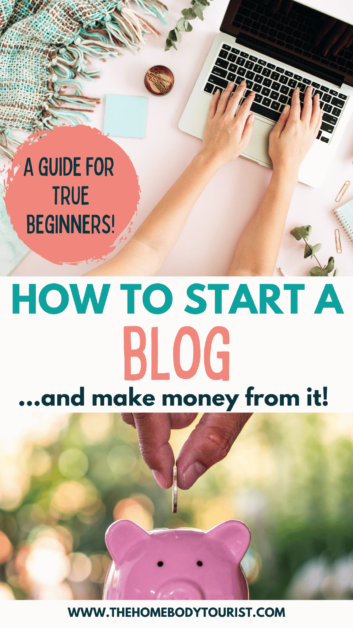How to Start a Blog for (TRUE) Beginners
Have you been tossing around the idea of starting a blog? But the actual act of starting the blog scares the bejeebers out of you. I know when I started this travel blog 3 years ago, I had absolutely no clue what I was doing. I was overwhelmed and almost gave it up 8,305 times (to be exact).
Three years later (and hours and hours and hours of learning and trial and error), I was able to quit my teaching job and I am making MORE THAN what I was making as an elementary teacher (with a dang master’s degree).
Yep, it’s crazy to me too.
The skills you learn from starting your own blog are so transferrable to other online businesses (I make money from freelance writing work as well). AND you can of course make money right from your own blog. Yes, it’ll take some time, but there’s no better time to start than now.
So buckle up (and grab a drink), because this is probably the most comprehensive (free) how-to start a blog for beginners post that you will find on the internet. And it’s all for free! (It’s truly the guide I wish I could have had because I wasn’t about to spend 1200 dollars on a course that “might” work).
I’m going to start from the very beginning and cover everything from choosing a niche to setting up your website. I’ll will also provide links to helpful resources that can guide you through the process.

This post does include affiliate links. I make a commission (at no cost to you) from some of the links. It’s what helps keeps these posts free and available to all! If you do choose to start a blog after reading this, I would be forever grateful if you start it by using the links below!
Table of Contents
What even is a blog?
A blog is a personal website that contains entries (or posts) written by the author. It is a collection of related articles or posts that are in some way helpful to the reader.
Bloggers can write about anything they want – from their daily thoughts and experiences to more in-depth topics like politics or fashion. If you are hoping to make money from your blog, it is important that your posts are useful and/or informative to their intended reader.
You’ll often find blogs on e-commerce sites or other online businesses as they are a great way to attract traffic to your website.
In my case, I share USA Weekend Guides and Dog-friendly City Guides.
Why start a blog?
There are many reasons why someone might want to start a blog, but some of the most common reasons include:
- To share information and ideas with others
- To express themselves creatively
- To build an online presence or brand
- To make money online (my personal favvvv)
How do you make money from a blog?
Before we get into the nitty-gritty details, you are probably wondering…How the heck do you make money from a blog? I will go into these in more detail throughout this post, but here are the most common ways.
So to answer your question…yes it is possible to make money blogging!
- Displaying ads on your website
- Affiliate marketing
- Selling products or services
- Sponsored posts
Keep reading to learn more about each of these ways!
Step by Step guide to Starting a Blog for Beginners (yes, real beginners)
When I first started this blog, I knew absolutely nothing. Truthfully I didn’t even know what a blog was. I saw a random pin on Pinterest about how to make money online (while searching for dinner ideas), and went down the rabbit hole from there. I had been ready to quit teaching for quite some time…sooo I was a motivated learner 🙂
Soooo after three years of blogging and hours upon hours of YouTube videos, podcasts, and reading how-to guides. Here’s my step-by-step guide on how to start a blog for beginners (grab a notebook and a pencil…and maybe a drink…and get to learning!)
Step One: Choose a niche
The first step in starting a blog that makes money is choosing a niche.
A niche is simply a specific topic or subject area that you are interested in and knowledgeable about.
When choosing a niche, be sure to pick one with enough potential audience to make it worthwhile. You don’t want to spend all your time working on something that no one will ever read.
Hint! You can install the Keyword Surfer (for free) by clicking here (and going to products then keyword extension). Once installed, you will be able to see the search volume for any niche idea.
How to choose a perfect niche for your blog?
There are a few things you need to consider when choosing a niche for your blog:
- The potential audience size: it is best to pick a niche in an area that has a good audience size. Would you want to go through the trouble of creating a blog just for no one to visit it? For example, if you choose to create a blog focused solely about one state park, you will likely run out of ideas to write about and the search volume may not be enough to make money.
- The level of competition in the niche: Some niches have a lot more competition than others. It is important to do your research and make sure you can be successful in the niche before choosing it BUT, do not let a little competition scare you away, there is room for more than one at the top.
- The interests of you and your target audience: This is probably the most important factor to consider when choosing a niche. Make sure the niche you choose interests both you and your target audience. Aim to pick a niche focused on topics you have the expertise, interests in, or passions. The truth is if you pick a niche you have no interest in, you may burn out quickly and give up on your blog.
- The profitability of the niche: Eventually, you’ll want to make money from your blog, so it is really important to consider the profitability of the niche that you choose. Some niches are more profitable than others, so make sure you do some research before deciding on a niche. Ask yourself what sorts of items could you sell/recommend inside of you niche?
The bottom line is when choosing a niche, think about what interests you and what you are knowledgeable about. Then, consider the needs of your target audience and try to find a niche that is interesting, informative, and helpful. Easy Peasy right?
Side note: I LOVE brainstorming niche ideas. If you want some help, just send me a message on Instagram and we can chat!
Profitable niche examples that can make money
Here are a few profitable niches that make money (in order of most to least money on average).
- Food and recipes
- Lifestyle (be careful with this one though as it also has the highest fail rate)
- Travel
- DIY and crafts
- Parenting
- Homeschooling
- Fashion and beauty
- Money and finance
- Health and Fitness
You can also decide to niche down further from these niches as long as your niche of choice has an audience.
For example, within the health and fitness niche, you can decide to focus on just the Keto diet. Or in my travel blog, I focus solely on dog-friendly USA travel and Weekend Getaway Guides. I HIGHLY recommend niching down further when you are just starting out.
Step 2: Pick a domain name

Once you have chosen your niche, the next step is to come up with a domain name for your website.
The domain name is the web address (or URL) for your website. It’s important to choose a domain name that is relevant to your niche and easy to remember.
When choosing a domain name, there are a few things you need to keep in mind:
- The domain name should be relevant to your niche. For example, if you are starting a blog about weight loss, you would want to choose a domain name like “weightloss.com” or “weightlosstips.com.”
- The domain name should be easy to remember. Make sure the domain name is easy to remember and spell. You don’t want people struggling to find your website because they can’t remember the name.
- The domain name should be unique. Make sure the domain name you choose is not already taken by another website or social channel. Even if the domain is available, you should still check Instagram, Youtube, and Facebook for any similar business names.
You can use a Domain Name Search Tool like GoDaddy or Bluehost to check for availability.
Once you have chosen a domain name, you will need to purchase it from a Domain Name Registrar. If you choose to host your blog on Bluehost (more on this below), you can get a FREE DOMAIN THE FIRST YEAR!
The cost of purchasing a domain name varies depending on the extension (e.g., .com, .net, .org) but typically costs around $15/year.
You can click here to search to see if you chosen domain name is available!
Step 3: Blogging Platform and Hosting


This is the part where I started getting confused (ya I know it’s only step 3). But, if you want to make money from your blog it’s important to get started on the right foot.
Although you have the option to self-host your website for free, this will limit your ability to make money from your blog as you don’t technically own it.
I STRONGLY recommended using WordPress.org (NOT wordpress.com) and then using Bluehost as your hosting platform.
What the heck does hosting mean? Hosting for a WordPress blog refers to the process of storing and making your blog accessible on the internet. When you create a WordPress blog, the files, databases, and media associated with your blog need to be stored on a server that is connected to the internet.
Why Bluehost?
It’s the hosting service I have used since starting my travel blog and I can full-heartedly recommend it! It’s very affordable, easy to use, my site speed is great, and the customer service has always been so very helpful when I have run into hiccups (even if I had no idea what I was asking them).
When just starting out, the basic plan is all you need! After purchasing, it will actually download WordPress for you and take you right to your new blog’s dashboard!!
Step 4: Set up your website

Now it’s starting to get real. Ahhh. You’ve purchased your domain and hosting and you are ready to create a beautiful and helpful blog!
This process can be a little daunting for first-timers, but don’t worry – I’ll do my best to walk you through it!
Once you have registered for web hosting and installed WordPress, the next step is to design your website. Your dashboard will look something like the above picture.
There are many free theme templates available online, or you can hire a designer to help you create a custom look for your blog. But, when just starting out (and on a budget), a free theme will work just fine.
Here are a few things to consider when deciding on a theme
- The theme should be responsive, meaning it looks good on all devices (desktop, tablet, and mobile).
- It’s important to choose a well-coded theme and not bloated with unnecessary features. This will help your website load quickly and look good on all devices. SIMPLE IS BETTER! You will soon find out that site speed is far more important than the look.
- It has to be SEO friendly (more on this later)
Many WordPress themes are both responsive and SEO friendly, so you can select the one you like best from the WordPress Dashboard.
Once you have selected a theme, it’s time to start adding content to your website. Some important pages to have on your website before launch includes;
- Legal Pages (Privacy Policy, Affiliate Disclosure, Disclaimer, and Terms and Conditions)
- An About Page: your about page should be about what you have to offer to your audience, why they should stick around on your blog, why they should be loyal fans, how they will benefit from your blog, and why you are the person for them to listen to.
- Contact Page
- Easy-to-search Categories/headings on the home page
I am NOT a lawyer or legal expert, I do suggest doing your own research into these legal pages to ensure you have all the information covered.
Step 5: Create content for your blog

The next step is to start writing content for your blog. YAY!
Now that you have set up your website, it’s time to start creating content for your blog. The key to creating great content is to think about what your target audience wants and needs. Try to produce content that is interesting, informative, and helpful. It would be best if you also aimed to publish new content regularly (at least one new blog post per week).
When creating content for your blog, remember to:
- Write in an engaging and exciting tone
- Use keyword-rich titles and descriptions (Read this blog post all about Keywords and SEO)
- Break up your content with headings and images
- Provide helpful resources and links (its good to link to other sites, plus super important to link within your own site)
- Use images to catch your readers attention. Make sure to compress the image size before uploading! (You can do this easily on Canva!)
Creating great content is essential for a successful blog. Try to produce content that is interesting, informative, and helpful. It would help if you also aimed to publish new content regularly.
Hint! Check out this post to learn what to do before pressing publish on your new posts!
Bonus tip! To grow the fastest, start by creating A LOT of content around the same topic. For example if you just took a trip to The Big Island, write one main itinerary post then many other more detailed and specific posts. This way, you can link within each blog post. It shows Google that you are an expert on that topic.
Another Example: You just started a blog all about German Shepherds. Your three main topics you will be covering are 1. Training 2. Behavior 3. Product Reviews. Focus just on writing posts within these three topics.
Step 6: Promote your blog

Once you have started publishing content on your blog, it’s important to promote it online. It’s not enough to just write and publish.
You can promote your blog by sharing links on social media sites like Facebook, Instagram, Pinterest and Twitter and guest posting on other websites.
Remember – the key is to be consistent with your marketing efforts and keep publishing valuable content that will interest your readers.
I recommend starting with just PINTEREST as this is a great way to get some traffic before google recognizes your site. Then, once you have more time you can add in the other social channels.
BUT I am NOT a fan of social media (I understand I live in 2023 so I have to be kind of on board) BUT THE BEST WAY to drive traffic to your blog is by using SEO techniques. By optimizing your website and content for the search engines, you can attract more visitors FOR FREE from Google and other search engines.
Here’s a post all about SEO for beginners!
Step 7: Monetize your blog

Finally, the last (and best) step in starting a blog that makes money is monetizing it.
This means finding ways to make money from your website through methods like advertising, affiliate marketing, or selling products and services.
There are many different ways to monetize a blog, and it depends on the niche and the business model. However, some common methods include:
Advertising:
Displaying ads (like you see on this website) is a common way to make money from blogging. Advertisers will pay you to place their ads on your blog, and you will earn a commission for every ad that is viewed.
Although you can start with Google Adsense, they do look a bit spammy and will lead to earning pennies. I recommend waiting until you have more traffic and applying to a different ad network such as SheMedia (as seen on this blog) or Mediavine.
Affiliate Marketing:
Affiliate marketing is a process where you promote other people’s products or services and receive a commission for every sale that you make.
There a several affiliate marketing networks out there that you can join and start making money recommending goods and services that you use and love. Or you can contact brands directly to see if they have their own in-house affiliate program.
When someone clicks on one of your affiliate links and makes a purchase, you will earn a commission from the sale.
Here are my favorite and most profitable affiliate programs!
Tip! Some people recommend waiting until you have XXX traffic, but I say the sooner you start embedding links and making a plan the better. It will also save you a lot of time down the road updating old posts. Travel Payouts is a great one to start with as there are hundreds of affiliates under one dashboard!
Product and Service Sales:
Selling your own products or services on your blog is another common way to make money.
You can either create and sell physical products or sell digital products and services. This way, you would receive 100 percent (minus cc fees) of profit vs. just a percentage that you see in affiliate marketing.
For example, you could offer paid subscriptions to your blog or sell digital eBooks, planners, itineraries, or other products. Check out my paid itineraries here!
If you have extra time you could also offer consultancy services through your blog such as coaching, travel planning, or budget help. This of course is not a passive way to earn money though.
Sponsored posts:
Sponsored posts are blog posts that you write for a company in exchange for money. Here’s an example of a sponsored post on my website. It’s still important that you are 100 percent honest in your review/post. You want your audience to trust your recommendations.
What else to do when you FIRST start your travel blog

As I stated before, blogging is a lot of work (but can be fun and pay off in the long run). In addition to simply starting your blog, there are several other things you should get done in the first month (or two) to ensure you are off to the right start. I will briefly list them here, but this post is getting a bitttttt long so click here for the full details!
- Make sure you have the right plugins (the fewer the better)
- Take a crash course in SEO (or listen to free podcasts or Youtube videos)
- Create your socials (just focus on one or two for the first few months…or years…I recommend Pinterest and then one of your choice- but its not a bad idea to secure your business name).
- Set up your Google Analytics
- Sign up for Amazon Affiliate (or other affiliates like Travel Payouts)
- Sign up for an email marketing service (I use ConvertKit)
Keep Reading:: What To Do in your First Month of Blogging
Helpful Courses and Videos Quick Guide
Besides googling and YouTubing thousands of How-to videos, these are the resources I found to be the most helpful.
I’m super cheap and did not want to invest a lot of money into starting a blog. The courses/resources I listed below are either free or very affordable.
- Blog Hosting: Bluehost (click this link to receive the promo price as well)
- How to Start a Blog: (free) 5 day Email Course I found many other helpful resources on their Blog as well!
- Pinterest Courses: Get Paid to Pin and Pinterest with Ell (This course comes with a VERY helpful Facebook group as well!)
- Affiliate: Amazon Affiliate Affluence
- Legal Help: (free) Legal Course for Beginners
- Pinterest Scheduler (this was a splurge, but saves SO much time) Tailwind (click the link to get 15 dollars off–and it’s much cheaper to pay for the whole year at once).
- Canva: My favorite blogging tool yet! Easily create pins and graphics to look more professional and help your brand! The paid plan is 100 percent worth it! Use this link to get 30 days for free!
- Travel Payouts: Is an awesome and easy to use travel affiliate dashboard. They have hundreds of affiliate programs under one account!
So are you ready to start a blog?
So there you have it – a step-by-step guide on how to start a blog that makes money.
It will be a lot of work, but it’s worth it in the end.
If you have any questions, feel free to leave a comment below or email me at thehomebodytourist@gmail.com or a DM on Instagram! I look forward to hearing from you and helping you start your own money-making blog!
Be the first to comment